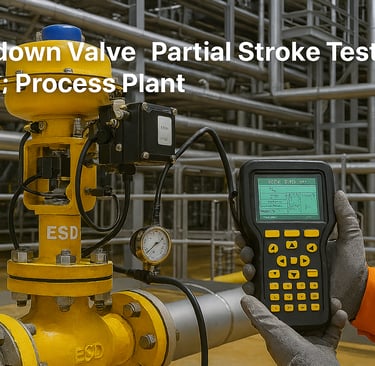Understanding IEC 61511: Guidelines on Proof Test Coverage
11/3/20257 min read


Introduction to IEC 61511
The IEC 61511 standard is a critical framework that governs the implementation of safety instrumented systems (SIS) within various industries, particularly in the process sector. Its primary objective is to ensure the safety and reliability of processes where hazards may pose significant risks to human life, the environment, and property. By establishing a systematic methodology for the design and management of SIS, IEC 61511 enhances overall operational integrity and safety performance.
Introduced by the International Electrotechnical Commission (IEC), this standard provides guidance to implement effective safety measures that mitigate risks associated with process operations. The significance of IEC 61511 lies not only in its focus on safety but also in its comprehensive approach that encompasses the entire lifecycle of safety instrumented functions, from concept to decommissioning. This lifecycle perspective ensures that safety considerations are embedded at every stage, thereby optimizing safety outcomes.
Compliance with IEC 61511 is essential for organizations aiming to safeguard their operations against potential failures that could lead to catastrophic incidents. By adhering to the guidelines set forth in this standard, companies engage in a structured risk assessment process that identifies hazards and quantifies the risks involved. Furthermore, it establishes the basis for determining the necessary safety integrity level (SIL) for each safety function, which is crucial in achieving an acceptable level of risk reduction.
Moreover, the standard promotes the continuous improvement of safety processes through regular proof testing and maintenance of safety systems. This ensures that the SIS remains effective over time, thereby reinforcing the commitment to safety and reliability. In summary, IEC 61511 serves as a foundational tool for organizations, providing the necessary guidelines to ensure that safety instrumented systems are designed, operated, and maintained to the highest standards of safety and performance.
Defining Proof Test Coverage
Proof test coverage is a fundamental concept within the realm of safety instrumented functions (SIF), particularly in industrial automation and safety systems. It refers to the extent to which a proof test can detect faults in a safety instrumented system (SIS). In essence, proof test coverage quantifies the reliability of safety functions by assessing how effectively a testing process can reveal failures that could potentially compromise system integrity. This metric is vital as it determines the overall safety performance of an operational environment.
The relationship between proof test coverage and the overall reliability of safety systems is quite significant. A high proof test coverage indicates a robust evaluation mechanism, ensuring that potential system failures are identified and rectified before they lead to hazardous incidents. Conversely, low proof test coverage may suggest that certain undetected failures could remain lurking in the system, thereby increasing the risks associated with overall system reliability. The proof test serves as an essential tool in validating that SIFs operate as intended, thereby safeguarding operational processes against failures and accidents.
Guidelines from IEC 61511 on Proof Test Coverage
The IEC 61511 standard provides comprehensive guidelines for proof test coverage, which is essential for ensuring the functional integrity of safety instrumented systems (SIS). One of the primary requirements detailed in the standard is that proof tests must be conducted to ascertain that the safety functions perform as intended. This involves a systematic approach to testing that assesses the system’s ability to operate under defined conditions, thereby identifying any potential failures that may impair safety.
According to IEC 61511, proof tests should be scheduled at appropriate intervals, determined by the safety lifecycle requirements and the operating context of the system. These intervals should be influenced by factors such as the system's reliability, the consequence of failure, and operating conditions. The standard emphasizes that conducting proof tests too infrequently may leave unnoticed degradation in system performance, while overly frequent testing may lead to unnecessary downtime.
Documentation and reporting practices also form a critical part of the proof test process as stipulated by the standard. Each proof test should be meticulously documented, including the results of the test, any anomalies discovered, and the subsequent corrective actions taken. This documentation serves as a critical resource for ongoing maintenance and can help in the evaluation of system performance over time. Furthermore, IEC 61511 recommends different types of proof tests, such as functional tests, partial tests, and comprehensive tests, each serving unique purposes based on overall system design and risk assessment.
Adhering to these guidelines is integral for enhancing reliability and safety in industrial operations. By implementing the principles laid out in IEC 61511 for proof test coverage, organizations can effectively manage risks associated with their safety systems while ensuring compliance with industry standards.
Considerations for SIL Calculation
When engaging in Safety Integrity Level (SIL) calculations, several critical factors must be considered to ensure a comprehensive assessment of safety and reliability. One of the most significant of these factors is proof test coverage. Proof tests play a pivotal role in the performance assurance of Safety Instrumented Functions (SIF). They serve as a systematic method to verify, validate, and ensure that safety systems operate as intended over time. The establishment of proof test coverage is vital; it effectively demonstrates the portion of the SIF that remains reliable after the completion of testing.
Moreover, it is essential to account for the mathematical implications of proof test coverage when computing SIL. Proof test coverage is typically quantified as a percentage, reflecting the extent to which potential failures can be detected and addressed by routine testing. For SIL calculations, this coverage impacts the determination of the performance capability of a safety instrumented system. The overall assessment incorporates various components such as failure rates and fault detection capabilities, which are integral to calculating the availability of the SIF. In this respect, the calculation of the safety function's reliability will determine the corresponding SIL required as per the facility's risk management framework.
Furthermore, adhering to the standards outlined in IEC 61511 is crucial during SIL calculations. This standard provides a structured methodology for evaluating the safety lifecycle, emphasizing the importance of incorporating factors such as proof test intervals, failure detection, and maintenance strategies. These considerations collectively contribute to a more comprehensive understanding of how proof test coverage influences SIF performance and, subsequently, SIL determination. The integration of these guidelines ensures that the calculations are not only compliant with regulatory requirements but also aligned with best industry practices.
Real-World Examples of Proof Test Coverage
Proof test coverage plays a crucial role in ensuring the safety and reliability of various industrial systems. As an illustration, consider the oil and gas sector, where a significant incident in a North Sea oil platform highlighted the importance of effective proof testing. In this case, a safety instrumented system (SIS) was evaluated, revealing a proof test coverage of approximately 60%. This relatively low coverage indicated that the system was at risk of undetected failures. By employing a more rigorous proof testing strategy, the company improved their coverage to approximately 90%, thereby significantly enhancing their safety posture and reducing the likelihood of catastrophic failures.
Another example can be drawn from the chemical processing industry. A major chemical manufacturer faced challenges with equipment malfunctions in their reactor systems, prompting a comprehensive review of their proof test coverage. The initial assessment showed that only 50% of the potential failures were covered by the existing testing protocol. Following this assessment, the manufacturer implemented a more thorough proof test protocol, which not only increased coverage to about 85%, but also included more frequent testing intervals. These adjustments resulted in a marked decrease in unplanned downtimes and maintenance costs, demonstrating the tangible benefits of robust proof test coverage.
In a different context, the power generation sector has also reported improvements through enhanced proof test coverage. In a case involving a gas turbine control system, a thorough assessment identified that critical failure modes were not adequately covered. By revising their testing strategy to focus on these high-risk areas, the operators elevated their proof test coverage from 75% to 95%. This proactive approach not only mitigated risks but also assured more stable and efficient operations, ultimately leading to improved performance metrics and compliance with international safety standards.
Challenges in Implementing Proof Test Coverage
Implementing proof test coverage in accordance with IEC 61511 guidelines can present various challenges for organizations across different industries. One of the primary obstacles is resource allocation. Organizations often struggle to find the necessary personnel who are not only skilled in the technical aspects of proof testing but also understand the regulatory requirements stipulated by the IEC 61511 standard. This shortage can lead to inadequate testing, which compromises the overall safety and reliability of Safety Instrumented Systems (SIS).
Another significant challenge is the need for effective training. The complexity of proof test procedures requires that personnel are well-versed in the specific techniques and methodologies relevant to their systems. However, many organizations encounter difficulties in developing comprehensive training programs. Without proper training, the staff may not accurately execute proof tests, resulting in a gap in compliance and potentially exposing the organization to safety risks. Hence, it is crucial for organizations to invest in training resources that align with IEC 61511 standards to enhance employee competence in this area.
Ongoing compliance with the IEC 61511 guidelines also poses challenges for organizations, particularly as technology and systems evolve. Continuous monitoring and updating of proof test coverage strategies are necessary to remain compliant; however, this can be resource-intensive and may often be neglected due to competing priorities. To address these challenges, organizations should consider implementing a structured compliance framework that includes regular reviews and updates of their proof test protocols. By fostering a culture of continuous improvement and leveraging existing technology for automation, organizations can ease the burden of compliance while ensuring safety and reliability in their operations.
Conclusion and Best Practices
In this discussion on IEC 61511, we have outlined the essential elements of proof test coverage and its critical role in the safety lifecycle of industrial processes. The IEC 61511 standard provides comprehensive guidelines that ensure safety systems are adequately tested and verified for functional integrity. Emphasizing the significance of rigorous testing, organizations must prioritize compliance with these standards to safeguard personnel and equipment in potentially hazardous environments.
Implementing best practices to enhance proof test coverage is vital for organizations aiming to achieve optimal safety and reliability. Firstly, it is crucial to develop a robust proof test plan that details the specific tests that are required for each safety instrumented function (SIF). This plan should encompass the frequency of testing, responsibilities, and performance criteria to be met. Documentation of all testing activities is also necessary, as it facilitates traceability and accountability.
Secondly, organizations should invest in training and resources for personnel involved in the execution of proof tests. A well-trained team is essential for performing tests accurately and recognizing any anomalies in safety systems that require attention. Regular refresher training programs can help maintain awareness of updated industry practices and technological advancements.
Additionally, it is advisable to utilize advanced diagnostic tools that assist in performing comprehensive proof tests. These tools can enhance the accuracy of test results and allow for efficient data analysis, providing insights into the reliability of the safety systems being assessed. By leveraging technology, organizations can streamline processes and adhere to the stringent requirements of IEC 61511.
In summary, maintaining effective proof test coverage is critical for safety in industrial processes. By adhering to the guidelines set forth in IEC 61511 and implementing these best practices, professionals can contribute significantly to the resilience and reliability of their safety systems.
